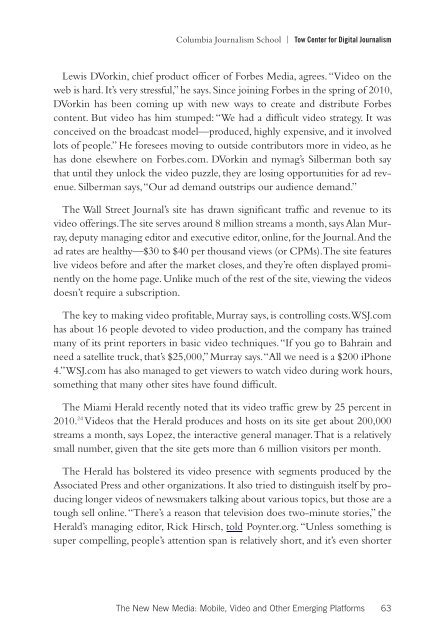What We Know About the Business of Digital Journalism
What We Know About the Business of Digital Journalism
What We Know About the Business of Digital Journalism
Create successful ePaper yourself
Turn your PDF publications into a flip-book with our unique Google optimized e-Paper software.
Columbia <strong>Journalism</strong> School | Tow Center for <strong>Digital</strong> <strong>Journalism</strong>Lewis DVorkin, chief product <strong>of</strong>ficer <strong>of</strong> Forbes Media, agrees. “Video on <strong>the</strong>web is hard. It’s very stressful,” he says. Since joining Forbes in <strong>the</strong> spring <strong>of</strong> 2010,DVorkin has been coming up with new ways to create and distribute Forbescontent. But video has him stumped: “<strong>We</strong> had a difficult video strategy. It wasconceived on <strong>the</strong> broadcast model—produced, highly expensive, and it involvedlots <strong>of</strong> people.” He foresees moving to outside contributors more in video, as hehas done elsewhere on Forbes.com. DVorkin and nymag’s Silberman both saythat until <strong>the</strong>y unlock <strong>the</strong> video puzzle, <strong>the</strong>y are losing opportunities for ad revenue.Silberman says, “Our ad demand outstrips our audience demand.”The Wall Street Journal’s site has drawn significant traffic and revenue to itsvideo <strong>of</strong>ferings. The site serves around 8 million streams a month, says Alan Murray,deputy managing editor and executive editor, online, for <strong>the</strong> Journal. And <strong>the</strong>ad rates are healthy—$30 to $40 per thousand views (or CPMs). The site featureslive videos before and after <strong>the</strong> market closes, and <strong>the</strong>y’re <strong>of</strong>ten displayed prominentlyon <strong>the</strong> home page. Unlike much <strong>of</strong> <strong>the</strong> rest <strong>of</strong> <strong>the</strong> site, viewing <strong>the</strong> videosdoesn’t require a subscription.The key to making video pr<strong>of</strong>itable, Murray says, is controlling costs. WSJ.comhas about 16 people devoted to video production, and <strong>the</strong> company has trainedmany <strong>of</strong> its print reporters in basic video techniques. “If you go to Bahrain andneed a satellite truck, that’s $25,000,” Murray says. “All we need is a $200 iPhone4.” WSJ.com has also managed to get viewers to watch video during work hours,something that many o<strong>the</strong>r sites have found difficult.The Miami Herald recently noted that its video traffic grew by 25 percent in2010. 24 Videos that <strong>the</strong> Herald produces and hosts on its site get about 200,000streams a month, says Lopez, <strong>the</strong> interactive general manager. That is a relativelysmall number, given that <strong>the</strong> site gets more than 6 million visitors per month.The Herald has bolstered its video presence with segments produced by <strong>the</strong>Associated Press and o<strong>the</strong>r organizations. It also tried to distinguish itself by producinglonger videos <strong>of</strong> newsmakers talking about various topics, but those are atough sell online. “There’s a reason that television does two-minute stories,” <strong>the</strong>Herald’s managing editor, Rick Hirsch, told Poynter.org. “Unless something issuper compelling, people’s attention span is relatively short, and it’s even shorterThe New New Media: Mobile, Video and O<strong>the</strong>r Emerging Platforms 63
















